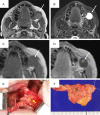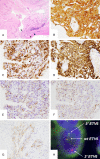Secretory carcinoma around Stensen's duct misdiagnosed as salivary duct cyst
- PMID: 32922622
- PMCID: PMC7476943
Secretory carcinoma around Stensen's duct misdiagnosed as salivary duct cyst
Abstract
Secretory carcinoma (SC) of the salivary gland was identified in 2010, and it is characterized by a specific ETV6 gene arrangement. The most common primary site for SC is the parotid gland; however, SC around the Stensen's duct is rare. Here we describe a rare case of a SC around the Stensen's duct that was initially misdiagnosed as a salivary duct cyst. A 59-year-old woman presented with a mass in the region of the left parotid papilla. Magnetic resonance imaging (MRI) revealed a well-circumscribed lesion and enhancement with a rim and an inner wall-like part that appeared in the late phase. Based on the initial clinical and imaging findings, a salivary duct cyst of the parotid gland was diagnosed. However, the lesion was histopathologically diagnosed as a SC based on immunohistochemical findings. The tumor cells showed diffuse positive staining for AE1/AE3, vimentin, and mammaglobin and focal positive staining for S-100 protein, SOX-10, and DOG-1. Fluorescence in-situ hybridization revealed ETV6 gene rearrangement in the tumor. In cases of cystic lesions around the Stensen's duct, clinicians should bear in mind that the possibility that they could be minor salivary gland cancers, such as SC.
Keywords: ETV6 gene arrangement; Secretory carcinoma; Stensen’s duct; mammaglobin; salivary duct cyst.
IJCEP Copyright © 2020.
Conflict of interest statement
None.
Figures



Similar articles
-
Sequential alterations of Stensen's duct and parotid gland after radical surgeries in buccal cancer.Oral Oncol. 2019 Sep;96:15-20. doi: 10.1016/j.oraloncology.2019.06.028. Epub 2019 Jul 3. Oral Oncol. 2019. PMID: 31422207
-
Primary squamous cell carcinoma of Stensen's duct in a patient with HIV: the role of magnetic resonance imaging and fine-needle aspiration.Head Neck. 2009 Feb;31(2):278-82. doi: 10.1002/hed.20889. Head Neck. 2009. PMID: 18642319
-
Clinical significance of buccal branches of the facial nerve and their relationship with the emergence of Stensen's duct: An anatomical study on adult Taiwanese cadavers.J Craniomaxillofac Surg. 2019 Nov;47(11):1809-1818. doi: 10.1016/j.jcms.2018.12.018. Epub 2019 Jan 4. J Craniomaxillofac Surg. 2019. PMID: 31537441
-
Mucoepidermoid carcinoma of Stensen's duct: a case report and review of the literature.Head Neck. 2005 Sep;27(9):829-33. doi: 10.1002/hed.20230. Head Neck. 2005. PMID: 15920747 Review.
-
Undifferentiated carcinoma arising from the Stensen's duct: a case report and review of the literature.Am J Otolaryngol. 2005 Nov-Dec;26(6):415-8. doi: 10.1016/j.amjoto.2005.05.003. Am J Otolaryngol. 2005. PMID: 16275415 Review.
Cited by
-
Macrocystic secretory carcinoma arising from the buccal minor salivary gland clinically mimicking a mucocele: A case report.Oncol Lett. 2024 Aug 12;28(4):493. doi: 10.3892/ol.2024.14626. eCollection 2024 Oct. Oncol Lett. 2024. PMID: 39185495 Free PMC article.
-
Diagnostic Utility of Expression Pattern of S100/Mammaglobin/SOX10/DOG 1 Immunohistochemistry in Differentiation of Secretory and Acinic Cell Carcinoma: A Systematic Review and Meta-Analysis.Indian J Otolaryngol Head Neck Surg. 2024 Feb;76(1):208-218. doi: 10.1007/s12070-023-04127-z. Epub 2023 Aug 14. Indian J Otolaryngol Head Neck Surg. 2024. PMID: 38440438 Free PMC article.
-
Radiological features of head and neck mammary analogue secretory carcinoma: 11 new cases with a systematic review of 29 cases reported in 28 publications.Neuroradiology. 2021 Nov;63(11):1901-1911. doi: 10.1007/s00234-021-02796-7. Epub 2021 Aug 24. Neuroradiology. 2021. PMID: 34427706
References
-
- Skalova A, Vanecek T, Sima R, Laco J, Weinreb I, Perez-Ordonez B, Starek I, Geierova M, Simpson RHW, Passador-Santos F, Ryska A, Leivo I, Kinkor Z, Michal M. Mammary analogue secretory carcinoma of salivary glands, containing the ETV6-NTRK3 fusion gene: a hitherto undescribed salivary gland tumor entity. Am J Surg Pathol. 2010;34:599–608. - PubMed
-
- Tognon C, Knezevich SR, Huntsman D, Roskelley CD, Melnyk N, Mathers JA, Becker L, Carneiro F, MacPherson N, Horsman D, Poremba C, Sorensen PH. Expression of the ETV6-NTRK3 gene fusion as a primary event in human secretory breast carcinoma. Cancer Cell. 2002;2:367–376. - PubMed
-
- Tognon C, Garnett M, Kenward E, Kay R, Morrison K, Sorensen PH. The chimeric protein tyrosine kinase ETV6-NTRK3 requires both Ras-Erk1/2 and PI3-kinase-Akt signaling for fibroblast transformation. Cancer Res. 2001;61:8909–8916. - PubMed
-
- Chiosea SI, Griffith C, Assaad A, Seethala RR. The profile of acinic cell carcinoma after recognition of mammary analog secretory carcinoma. Am J Surg Pathol. 2012;36:343–50. - PubMed
Publication types
LinkOut - more resources
Full Text Sources
Miscellaneous
